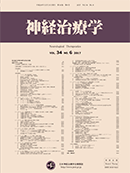Volume 34, Issue 2
Displaying 1-17 of 17 articles from this issue
- |<
- <
- 1
- >
- >|
-
2017 Volume 34 Issue 2 Pages 65
Published: 2017
Released on J-STAGE: July 25, 2017
Download PDF (222K)
-
2017 Volume 34 Issue 2 Pages 67-70
Published: 2017
Released on J-STAGE: July 25, 2017
Download PDF (1341K)
-
2017 Volume 34 Issue 2 Pages 71
Published: 2017
Released on J-STAGE: July 25, 2017
Download PDF (253K) -
2017 Volume 34 Issue 2 Pages 72-78
Published: 2017
Released on J-STAGE: July 25, 2017
Download PDF (1636K) -
2017 Volume 34 Issue 2 Pages 79-85
Published: 2017
Released on J-STAGE: July 25, 2017
Download PDF (2868K) -
2017 Volume 34 Issue 2 Pages 86-94
Published: 2017
Released on J-STAGE: July 25, 2017
Download PDF (4411K) -
2017 Volume 34 Issue 2 Pages 95-100
Published: 2017
Released on J-STAGE: July 25, 2017
Download PDF (900K) -
2017 Volume 34 Issue 2 Pages 101-106
Published: 2017
Released on J-STAGE: July 25, 2017
Download PDF (991K) -
2017 Volume 34 Issue 2 Pages 107-111
Published: 2017
Released on J-STAGE: July 25, 2017
Download PDF (2387K)
-
2017 Volume 34 Issue 2 Pages 112-116
Published: 2017
Released on J-STAGE: July 25, 2017
Download PDF (985K) -
2017 Volume 34 Issue 2 Pages 117-120
Published: 2017
Released on J-STAGE: July 25, 2017
Download PDF (1450K) -
Diaphragm pacing in amyotrophic lateral sclerosis ―A long–term analysis of safety and effectiveness―2017 Volume 34 Issue 2 Pages 121-124
Published: 2017
Released on J-STAGE: July 25, 2017
Download PDF (855K)
-
2017 Volume 34 Issue 2 Pages 125-126
Published: 2017
Released on J-STAGE: July 25, 2017
Download PDF (359K)
-
2017 Volume 34 Issue 2 Pages 127-128
Published: 2017
Released on J-STAGE: July 25, 2017
Download PDF (450K)
-
2017 Volume 34 Issue 2 Pages 129-132
Published: 2017
Released on J-STAGE: July 25, 2017
Download PDF (367K) -
2017 Volume 34 Issue 2 Pages 133
Published: 2017
Released on J-STAGE: July 25, 2017
Download PDF (251K) -
2017 Volume 34 Issue 2 Pages 134
Published: 2017
Released on J-STAGE: July 25, 2017
Download PDF (200K)
- |<
- <
- 1
- >
- >|
